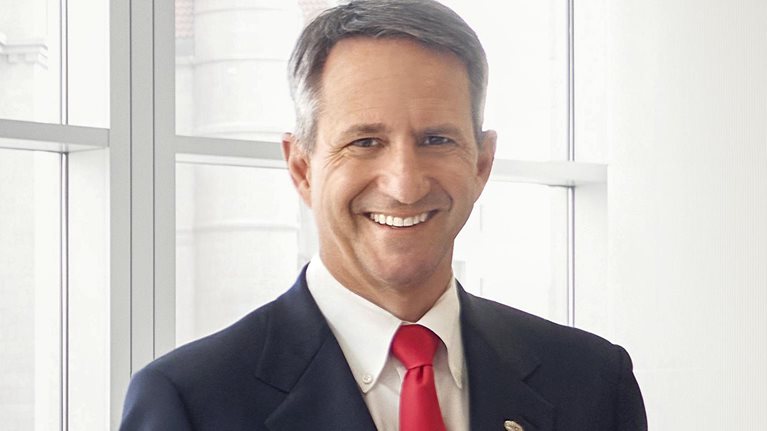As chief people and sustainability officer for Xylem, a global water solutions provider, Claudia Toussaint has helped oversee an operating model transformation that is on track to meet its strategic goals. In an interview with McKinsey Senior Partner Brooke Weddle, Toussaint discusses how analytics and other tools—including tiny robots that can crawl through pipes to warn of potential water breaks—reflect the company’s sustainability principles and bring value to customers.
Toussaint explains why focusing on people, processes, and purpose is the way to build support for a transformation. Homing in on what needs to change is crucial, she notes, but so is knowing what a company should preserve. She has been surprised by “how resilient an organization can be—and how much untapped talent can be found to help champion change.” And speaking of resilience, Toussaint discovered her own in a surprising encounter with the University of California, Los Angeles (UCLA), her dream school that almost wasn’t.
Brooke Weddle: You’ve been at Xylem for ten years now. Tell us about the company.
Claudia Toussaint: Xylem is a global water solutions provider. We transport, treat, analyze, and meter water—both clean water and wastewater—for municipal, industrial, and commercial customers. We have about 23,000 employees and operate in more than 150 countries. Our emphasis is on building a more water-secure world.
Brooke Weddle: Xylem works on a lot of interesting projects. What are you most excited about?
Claudia Toussaint: I’m excited about a lot of what we’re doing, so it’s hard to think of just one project. But I will share a customer solution we’re providing that I think many people can relate to. There are millions and millions of people across the globe who don’t have access to safe drinking water. But if we’re lucky enough to have a water faucet, when we turn it on, 20 to 70 percent of that water, depending on where you are in the world, will have been lost. In other words, your water provider, your utility, produces between 120 and 170 percent of what reaches you.
When you think about an industry where that much loss happens in the process, the need for technologies to reduce that loss is completely self-evident. We have solutions that include some really cool robots that crawl through pipes to give utilities advance notice of where a water break might happen. We also have smart meters that help pinpoint small leaks well before a customer might notice an increase on their bill, and analytics that advise the utility about where those leaks are and how to repair them. We have data analytics that enable utilities to model their networks to help them advance and improve their maintenance.
Sustainability is a big part of our mission. For us, sustainability comes to life when we can provide a more energy-efficient solution that the customer will then deploy to reduce their energy bill and their greenhouse gas emissions. When we talk about sustainability at Xylem, we have always talked about it from the position of how sustainability can create value for our customers. That is a critical point for companies to think about.
Risk taking and resilience
Brooke Weddle: Tell us a little bit about yourself and your background. What were the personal and professional markers that led you to Xylem and your roles today?
Claudia Toussaint: My professional career took a lot of twists and turns, and my background might not be typical for a chief people officer. I was a corporate lawyer for nearly 30 years. I came to Xylem ten years ago and was general counsel before taking on my current roles in human resources and sustainability.
When it comes to personal and professional markers, I believe that you don’t really know until afterward if they were important events that changed your path. I do know that I’m a risk taker. Risk taking is how I look at opportunities, both personally and professionally.
As I reflect today, a couple of key experiences come to mind. One is that I came to the United States from Germany with $500 to my name. I also had an experience early on that taught me the value of resilience. There was only one school I wanted to go to: UCLA. This was before digital applications that allow potential students to apply to a dozen or more schools. I was convinced I would get in. But UCLA didn’t feel the same way initially.
Because I was living in Los Angeles at the time, I decided to go to the admissions office. I’m sure they didn’t know what to expect when I showed up. But my objective was to understand their reservations and why I wasn’t admitted—and what I could do better. I was genuinely curious. The outcome of that visit was tremendous, because I ended up getting admitted.
That experience helped me learn how to overcome obstacles by being resilient, but also by adopting an authentic learning mindset. When you want to understand something, a learning mindset helps you inform yourself, and it also doesn’t put the person you’re interacting with on the defensive. I took these lessons with me into my career.

Organize to Value
Build your operating model with value at the core
Brooke Weddle: Xylem recently embarked on an enterprise operating model transformation. What sparked it?
Claudia Toussaint: There were actually two catalysts. The first was related to a transformative acquisition in 2023, when we acquired Evoqua Water Technologies, a water treatment company. The second was the planning and execution of a CEO transition. It was the perfect time because we were contemplating changes in leadership and had a change in the composition and scale of the company. This gave us an opportunity to step back and create an operating model that would make the combined company successful.
Companies have different definitions of what an operating model transformation entails. We defined it holistically, meaning we focused on culture, processes, and organizational structure.
Many companies start with structure first, but we started with culture because we had the acquisition. Sometimes when going through mergers and acquisitions, if you don’t pay attention to culture, you risk not realizing the full potential of the combination. That’s particularly the case when you have a transformative transaction. So we looked at culture as a derisking mechanism for making the acquisition successful.
Another differentiating factor is that many times when companies think about operating model changes, they are at a negative inflection point. But we embarked on our transformation from a position of strength. Over a ten-year period, we performed in the top quartile from a shareholder return perspective when viewed against our peers. We asked ourselves, how are we going to replicate that for the next five or ten years? Is our operating model designed to enable that? If not, what changes are needed?
Part of what we discovered in the culture work and in thinking about how to be successful over the next decade was around key processes. We also had clear and defined outcomes that we rallied people around. One was ensuring a successful integration of the two companies. The other was rapidly becoming an exceptional operator at scale to unlock value. The objective was to drive margin improvement and EBITDA growth over the short term and get to above-market revenue growth rates over the longer term. The other critical objective was to build our leadership bench. We wanted to make sure that we were creating the business leaders of the future.
From calling people out to ‘calling them in’
Brooke Weddle: You say that culture was a foundational element of the operating model transformation. How did you think about your change management approach and strategy?
Claudia Toussaint: We wanted to understand not just the project-related and technical aspects of change but also the human aspects. We wanted to build capabilities in change management. To mobilize the organization, we had to be able to tell a compelling change story and focus on why we had to change, especially coming from a position of strength. A change story is only as compelling as the leaders who model it and take it to the rest of the organization. We did a lot of work as an executive-leadership team to bolster our skills in this area.
We had all our C-suite executives go through a workshop on what it means to sponsor change and how an aligned leadership team behaves. It’s very easy for everyone to say, “I agree we can make the business case for transformation.” But to say, “I’m aligned to the transformation,” means you’re going to make different decisions with both the financial capital and the human capital you have control over.
We did a lot of work individually and as a team to practice the right behaviors. We would call each other out for good role modeling—but also when someone fell short. We did this in a constructive way, by inviting the person to reflect on how they showed up in a meeting, for example.
It took practice to reach that level of trust. We did something that I think was powerful, though it may sound simple: We took the behaviors we wanted to see and asked ourselves, “How can we live the high-impact culture? How do we need to show up for our teams?”
Calling people out ended up being more about “I’m calling you in.” This simple turn of phrase creates a way for a leader to show up differently. You can’t just put it on a piece of paper; you have to put in the time and do the work as a leadership team.
Team spirit
Brooke Weddle: You brought along and engaged a broader group of leaders. Tell us about the leadership journey that you embarked on as part of the transformation.
Claudia Toussaint: Early on, we knew that we needed a group of leaders across the globe that we could enlist to help us champion and execute the operating model change. So we selected a relatively small team of 150 leaders who were our direct reports.
We made a couple of strategic decisions. The first was that we were radically transparent with them. A lot of times, when you go through an operating model change, by the time you think about structure, you’re being fairly secretive about it. But we were transparent with that team, which built trust. Those 150 leaders became advisers to the C-suite.
We told people, “We’re going to invest in your development so that you are able to fulfill your role well.” We took that group of 150 people through a six-week learning program that focused on aligned leadership. We had the team discuss their role in the change and the importance of applying a uniform change management methodology.
We’ve seen some early positive results. We’re hearing from our colleagues that they can now focus on the customers that will bring the greatest value to the organization and that our colleagues are in the best position to serve. What we’re hearing from channel partners is, “I love that I have a clear point of contact for meeting my needs.”
In terms of operating model structure, one of the key changes was to move from a highly matrixed organizational and decision-making design to vertically integrated business units. That shift provided greater clarity in terms of who is authorized to make decisions. One of the other benefits we’re seeing is in speed of decision-making.
Brooke Weddle: What were some of the more granular changes you made to the operating model?
Claudia Toussaint: We discovered that teams are the power unit in an organization and that effective teams are critical to our success. Part of that was realizing that not everybody needed to participate in every decision or be in every meeting. For example, steering committees should be small and very clear about their purpose. We also emphasized to people that when you go to meetings, know what your role is. Are you somebody who is actively shaping the discussion, or do you just need to be informed of the outcome?
That was a difficult part of our cultural transformation, because we have tended to have too many decision-makers, which can be a potential drag on performance as volatility, disruption, and the pace of business accelerates. We were trying to move away from overcollaborating to collaborating well.
Comfort (and discomfort) zones
Brooke Weddle: Can you describe your role in the transformation?
Claudia Toussaint: I wore multiple hats. Part of that was a result of the unique context of the transformation—the integration of two companies and a CEO transition. The ability to work well with both the incoming CEO and the departing CEO, as well as the board, was crucial to providing continuity.
With respect to the culture, I knew what needed to change and what needed to be preserved. For example, we have real competitive advantages that are important to retain. One of them is that we are a purpose-driven organization. Purpose attracts talent and drives people to be engaged and to give 150 percent. As we were going through the transformation, retaining our focus on purpose was important. The other piece was that we have a reputation as a sustainability leader for the way we have integrated sustainability into our strategy and operationalized it in our business. That was also something to retain.
Brooke Weddle: What have you learned so far?
Claudia Toussaint: You don’t wake up one morning and say, “I want to embark on an operating model change.” What I learned is that moving with speed may be painful at times, but it’s absolutely necessary. I’m a long-time practitioner of yoga, and the great yoga teachers say that the pose starts when you really want to get out of the pose. That means true growth takes place when we push beyond our comfort zones.
There were moments during the operating transformation when I felt, “OK, we’re at a point where I’m not sure we can do it.” But I’m really glad we moved with speed and moved through the pain.
The second piece is, don’t do it alone. There is real value in having a partner who will make sure you have the right metrics and objective rigor around the process. Third, the CEO needs to be all in. Because a transformation of this magnitude must be driven by the CEO’s deep conviction and an aligned board.
Finally, I was surprised by how resilient an organization can be—and how much untapped talent can be found to help champion change.
Make it simple
Brooke Weddle: You’ve said how important it is for Xylem to have a strong sense of purpose. Now that you’re fully into the operating model changes, how do you keep purpose front and center?
Claudia Toussaint: The good thing is that purpose is part of our DNA. When we launched the operating model redesign, we took rather complicated vision and mission statements and turned them into a simple purpose statement centered on enabling and empowering our customers and communities to build a water-secure world.
In fact, making things simple was the key theme throughout the operating model transformation. We kept the language simple, and we kept the number of behaviors simple because we wanted people to remember them. The same is true for our new purpose statement.
Brooke Weddle: The role of chief people officer has changed a bit over the past few years, as have the core capabilities required to be successful in that role. What are the main opportunities for chief people officers now?
Claudia Toussaint: A great opportunity for chief people officers is to understand what the volatility of the external environment can do to their business and what the talent and people implications are. Every organization on the planet is thinking through how to leverage AI, both in terms of customer-centric use cases and in terms of augmenting leaders’ capabilities. If leaders walk the talk, the organization will see the potential benefits of AI much faster.
When it comes to the human resources function in particular, the vision is to act as an enabler for talent and capability building for the organization. To do that well, you have to leverage AI. Frankly, AI is part of the enterprise capabilities we need to build. AI plays a big role in augmenting how every one of our knowledge workers will do their work.
Parts of our organization are scared about AI, both from an ethical perspective and from the personal side—is AI going to replace me? Chief people officers have an opportunity to be very purposeful in discussing what roles and tasks may change and where there are opportunities.
Brooke Weddle: Reflecting on all that has happened with Xylem’s transformation, what advice do you have for executives who are about to embark on their own operating model transformations?
Claudia Toussaint: Have conviction. Make sure that the CEO buys in. Because if you don’t have that level of support, the organization will sense it, and you will lose momentum. Move with speed.
Second, always be curious and ready to learn. If we’ve realized anything over the last couple of years, it is that change and disruption are constant. The people and executives who invest in their own learning are going to be able to add more value to their organizations.
Third, invest in building relationships, not only with the CEO but with the whole C-suite and the board. When those relationships work well, it allows you to have a much stronger voice as a strategic executor or adviser on topics that are beyond the function.


